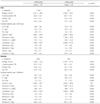1. The Third Korea National Health and Nutrition Examination Survey (KN-HANESIII). 2006. Korea Centers for Disease Control and Prevention.
3. Lichtenstein AH, Appel LJ, Brands M, Carnethon M, Daniels S, Franch HA, et al. Diet and lifestyle recommendations revision 2006: A Scientific Statement from the American Heart Association Nutrition Committee. Circulation. 2006. 114:82–96.
4. Summary: Food, nutrition, physical activity, and the prevention of cancer: a global perspective. 2007. World Cancer Research Fund. American Institute for Cancer Research;9.
5. Ibiebele TI, Pols IC, Hughes MC, Marks GC, Williams GM, Green AC. Dietary pattern in association with squamous cell carcinoma of the skin: a prospective study. Am J Clin Nutr. 2007. 85:1401–1408.

6. Choi MK, Bae YJ. A study on blood lipids and blood pressure of adult men and women according to vegetable intake. Korean J Community Nutrition. 2007. 12(6):761–722.
7. Hung HC, Joshipura KJ, Jiang R, Hu FB, Hunter D, Smith-Warner SA, et al. Fruit and vegetable intake and risk of major chronic disease. J Natl Cancer Inst. 2004. 96(21):1577–1584.

8. Nöthlings U, Schulze MB, Weikert C, Boeing H, Schouw YT, Bamia C, et al. Intake of vegetables, legumes, and fruit, and risk for all-cause, cardiovascular, and cancer mortality in a European diabetic population. J Nutr. 2008. 138(4):775–781.

9. Serdula MK, Gillespie C, Kettel-Khan L, Farris R, Seymour J, Denny C. Trends in fruits and vegetable consumption among adults in the united states: Behavioral risk factor surveillance system, 1994-2000. Am J Public Health. 2004. 94:1014–1018.

10. Riediger ND, Shooshtari S, Moghadasian MH. The influence of sociodemographic factors on patterns of fruit and vegetable consumption in Canadian adolescents. J Am Diet Assoc. 2007. 107:1511–1518.

11. Taylor JP, Evers S, Mckenna M. Determinants of healthy eating in children and youth. Can J Public Health. 2005. 96:supple3. S20–S26.
12. Oliver LN, Hayes MV. Neighbourhood socio-economic status and the prevalence of overweight Canadian children and youth. Can J Public Health. 2005. 96:415–420.

13. Son SM, Park Y, Lim H, Kim S, Jeong Y. Sodium intakes of Korean adults with 24-hour urine analysis and dish frequency questionnaire and comparison of sodium intakes according to the regional area dish group. Korean J Community Nutrition. 2007. 12(5):545–558.
14. Striegel-Moore RH, Thompson D, Affenito SG, Franko DL, Obarzanek E, Barton BA, et al. Correlates of beverage intake in adolescent girls: the National Heart, Lung, and Blood Institute Growth and Health Study. J Pediatr. 2006. 148:183–187.

15. Milne DB, Nielsen FH. The interaction between dietary fructose and magnesium adversely affects macromineral homeostasis in men. J Am Coll Nutr. 2000. 19:31–37.

16. Sartorelli DS, Franco LJ, Gimeno SGA, Ferreira SRG, Cardoso MA. Dietary fructose, fruits, fruit juices and glucose tolerance status in Japanese-Brazilians. Nutr Metab Cardiovasc Dis. 2008. 19(2):77–83.

17. In-Depth Analysis on the 3rd (2005) Korea Health and Nutrition Examination Survey-NutritionSurvey-. 2007. Korea Centers for Disease Control and Prevention.
18. Moon HK, Park JH. Comparative analysis and evaluation of dietary intake between with and without hypertension using 2001 Korea National Health and Nutrition Examination Survey (KNHANES). Korean J Nutr. 2007. 40(4):347–361.
19. Umesawa M, Iso H, Date C, Yamamoto A, Toyoshima H, Watanabe Y, et al. Relation between dietary sodium and potassium intakes and mortality from cardiovascular disease: the Japan Collaborative Cohort Study for evaluation of cancer risks. Am J Clin Nutr. 2008. 88:195–202.

20. Casagrande SS, Wang Y, Anderson C, Gary TL. Have Americans increased their fruit and vegetable intake? The trends between 1988 and 2002. Am J Prev Med. 2007. 32(4):257–263.

21. Giskes K, Turrell G, Patterson C, Newman B. Socio-economic differences in fruit and vegetable among Australian adolescents and adults. Public Health Nutr. 2002. 5(5):663–669.

22. Drewnowski A, Specter SE. Poverty and obesity: the role of energy density and energy costs. Am J Clin Nutr. 2004. 79:6–16.

23. Riediger ND, Moghadasia MH. Patterns of fruit and vegetable consumption and the influence of sex, age and socio-demographic factors among Canadian elderly. J Am Coll Nutr. 2008. 27(2):306–313.

24. Paquette M. Perceptions of healthy eating: state of knowledge and research gaps. Can J Public Health. 2005. 96:supple3. S15–S19.







 PDF
PDF ePub
ePub Citation
Citation Print
Print






 XML Download
XML Download